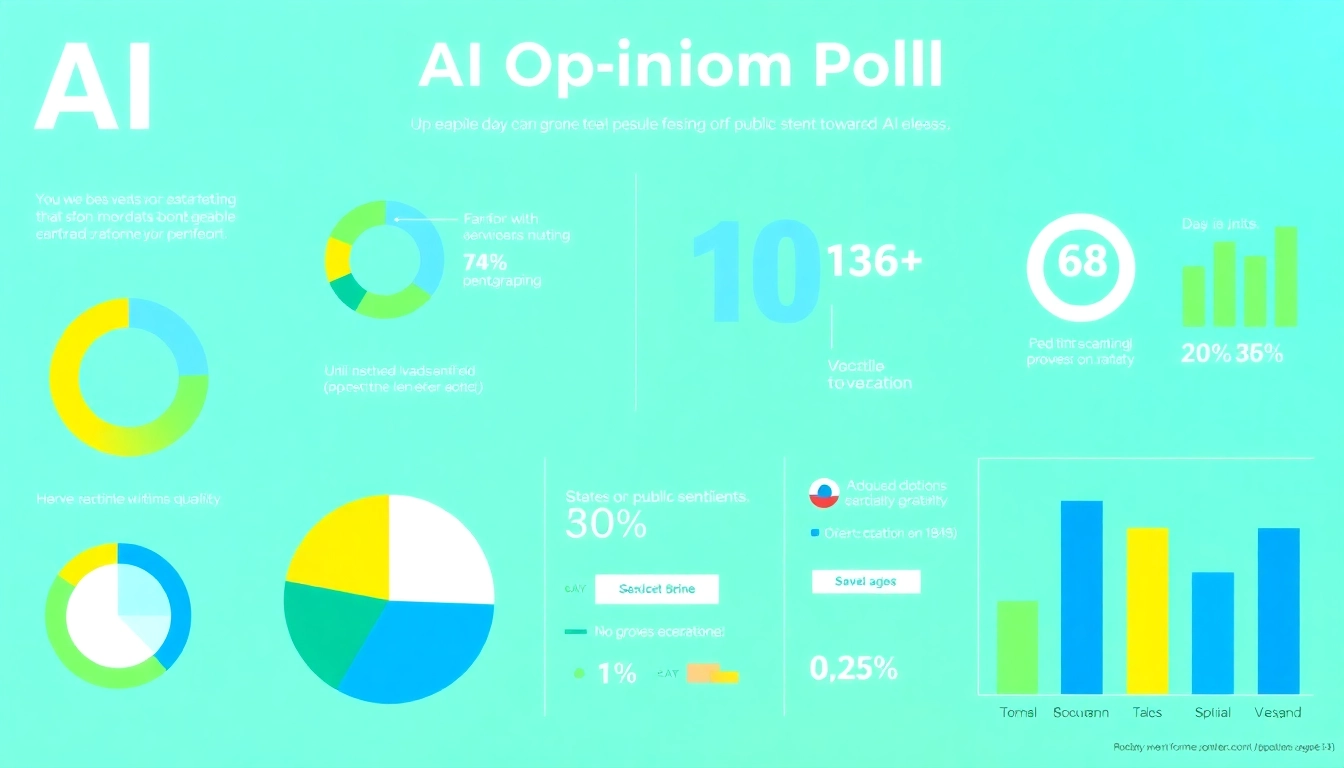
Introduction to AI Opinion Polls
In today’s rapidly evolving technological landscape, understanding public sentiment towards innovations is imperative, especially when it comes to artificial intelligence (AI). AI opinion polls serve as essential tools that gauge how the general populace perceives AI technologies and their implications for society. As AI continues to permeate various sectors, from business to healthcare and beyond, capturing the nuances of public opinion becomes increasingly vital. This article delves deep into the world of AI opinion polls, exploring their definitions, importance, and the significant role they play in shaping AI development, while also referencing insightful data from recent surveys, such as those available at AI Opinion poll.
Defining AI Opinion Polls
AI opinion polls are structured surveys specifically designed to elicit attitudes, beliefs, and expectations regarding artificial intelligence from a diverse array of participants. These polls not only collect quantitative data but also capture qualitative insights that highlight the emotional and rational underpinnings of public sentiment. Typically conducted by research organizations, universities, or consulting firms, AI opinion polls may cover various domains, including trust in AI technologies, perceived benefits and drawbacks, and expectations for the future of AI.
Importance of Public Sentiment
Public sentiment plays a crucial role in the adoption and integration of AI technologies. Understanding how the public perceives AI can direct efforts in education, policy-making, and innovation. For instance, if a significant portion of the population holds negative views of AI, this could stall technological advancements and create barriers to implementation. Conversely, positive sentiment can foster acceptance and encourage investment in AI research and development. Recent surveys indicate that, for instance, 52% of Americans report being more concerned than excited about AI in their daily lives, underscoring the need for dialogue and education to bridge these emotional gaps.
How Polls Shape AI Development
AI opinion polls do more than reflect existing attitudes; they significantly influence how developers, stakeholders, and policymakers approach technology. The data collected from these polls provides insight into public concerns, aspirations, and expectations, enabling developers to tailor AI applications that are not only innovative but also socially acceptable. Furthermore, policymakers can utilize this data to formulate regulations that address public concerns, thereby creating a framework within which AI can be developed responsibly. Overall, the insights garnered from opinion polls can lead to more ethical and user-centric AI technologies.
Key Findings from Recent AI Opinion Polls
General Sentiment Towards AI Technology
Recent findings from various surveys illustrate a complex relationship between the public and AI technologies. Data highlight a significant divide in opinions; while many people acknowledge the potential benefits of AI, a considerable number express skepticism and concern regarding its impact. For example, surveys reveal that a large segment of the population perceives AI as a threat, particularly to employment opportunities and personal privacy. Additionally, many individuals have expressed unease about AI’s ability to perpetuate biases and misinformation. This dichotomy in public opinion underscores the need for clearer communication and education on AI’s capabilities and limitations.
Concerns Over AI and Job Security
A pressing concern that consistently emerges in AI opinion polls is the impact of AI on job security. Many respondents fear that the integration of AI into various industries will result in widespread job displacement, particularly in sectors such as manufacturing, retail, and transportation. Polls show that around 41% of Americans believe that AI does more harm than good, especially regarding employment stability. These sentiments reflect a broader anxiety about the implications of technological advances on the workforce, fueling discussions about the need for retraining, upskilling, and adapting educational paradigms to prepare future generations for an AI-driven economy.
Impact of AI on Daily Life
The impact of AI on daily life remains a topic of significant interest and debate in public opinion surveys. Reports indicate that while many Americans utilize AI technologies in their everyday activities, from virtual assistants to recommendation algorithms, there is widespread unease regarding how these technologies influence personal privacy and decision-making. For instance, surveys indicate that 72% of participants have a negative perspective on AI’s potential to spread misinformation, while concerns about surveillance and data privacy continue to grow. This lingering mistrust highlights the need for more transparency and accountability in AI deployment.
Methodologies Used in AI Opinion Polling
Approaches to Data Collection
The methodologies employed in conducting AI opinion polls vary widely, encompassing both quantitative and qualitative approaches. Quantitative methods often involve large-scale surveys that utilize structured questionnaires to gather numerical data on public sentiment. These surveys can be administered through various platforms, including online panels, telephone interviews, and face-to-face interactions. Qualitative approaches, on the other hand, may involve focus groups and open-ended interviews that seek to delve deeper into individual experiences and opinions regarding AI. By combining these methodologies, researchers can obtain a comprehensive understanding of public perceptions.
Demographic Considerations
Understanding the demographic context of survey respondents is crucial for interpreting the results of AI opinion polls. Factors such as age, gender, education level, and geographic location can influence perspectives on AI technologies. For instance, research suggests that women tend to express higher levels of skepticism about AI than men, reflecting different societal roles and expectations. Similarly, younger respondents may view AI through a more optimistic lens compared to older generations who may possess reservations rooted in personal experiences. By disaggregating data according to demographic variables, pollsters can uncover nuanced insights about how diverse populations perceive AI.
Analysis Techniques
The analysis of data collected from AI opinion polls employs a range of statistical and qualitative techniques aimed at interpreting the results and drawing meaningful conclusions. Quantitative data may undergo statistical tests to determine significance and correlations, while qualitative data requires thematic analysis to identify common patterns and sentiments. Data visualization tools are also essential in presenting findings in a digestible format. Synthesizing both types of data can elucidate trends and anomalies, offering a holistic perspective on public sentiment towards AI.
Comparative Analysis of AI Opinion Poll Results
Trends Over Time
Comparative analysis of AI opinion polls over time reveals evolving public sentiments as AI technologies develop and become more integrated into daily life. Historical data indicates a trend where initial excitement over AI’s potential has given way to increasing skepticism, particularly concerning ethical implications and societal costs. For instance, longitudinal studies show that public concerns about unemployment due to automation and job displacement have risen significantly, correlating with increased media coverage and real-world applications of AI in labor markets. Tracking these trends helps stakeholders understand shifting attitudes and adjust communication strategies accordingly.
Regional Insights
Regional differences also play a crucial role in shaping opinions on AI. Polls reveal that urban populations, typically exposed to advanced technology and AI utilization, often have different perceptions compared to rural populations, where access may be limited. For example, surveys from different states illustrate that residents in technology hubs maintain a more favorable outlook on AI than those in regions less familiar with its applications. By examining regional insights, developers and policymakers can tailor outreach efforts to address specific concerns and enhance technology literacy accordingly.
Comparisons with Other Technologies
Comparing AI opinion polls with sentiments towards other emerging technologies, such as biotechnology or renewable energy, provides valuable context for understanding public perspectives. Many polls indicate that while there is a general awareness of the risks associated with AI, similar concerns are echoed in other fields. This comparative analysis highlights broader societal unease with rapid technological changes, often fueled by fears of the unknown and potential negative consequences. Such insights can assist organizations in framing AI within the wider technological landscape, enabling more comprehensive communication strategies.
Future Implications of AI Opinion Poll Results
Guiding AI Policy and Regulation
The implications of AI opinion polls extend far beyond academic interest; they hold significant weight in shaping public policy and regulatory frameworks. Policymakers can leverage data from these polls to understand public concerns and preferences regarding AI, ensuring that regulations reflect societal values and uphold ethical standards. For example, as noted in recent findings, public skepticism surrounding data privacy emphasizes the necessity for robust regulatory oversight in AI applications, particularly in sectors like healthcare and consumer technology.
Potential for Public Engagement
AI opinion polls also serve as a catalyst for public engagement, facilitating dialogue between stakeholders, industry leaders, and the general populace. By presenting findings from polls through public forums, organizations can encourage active participation in discussions on AI’s societal implications. This engagement is crucial for building trust and promoting transparency in AI development. Ultimately, involving the public in conversations about AI fosters a collaborative environment where concerns are acknowledged, and solutions can be developed collectively.
Driving Ethical AI Development
As the discourse around AI continues to evolve, the ethical implications of its development and deployment remain paramount. AI opinion polls can inform policies that promote ethical practices by highlighting public perceptions of fairness, bias, and accountability in AI systems. For instance, issues surrounding transparency in algorithmic decision-making have gained traction in recent surveys, indicating a growing demand for ethical AI practices that respond to societal values. By incorporating public sentiment into the development process, stakeholders can ensure that AI technologies align more closely with the interests and welfare of society.







